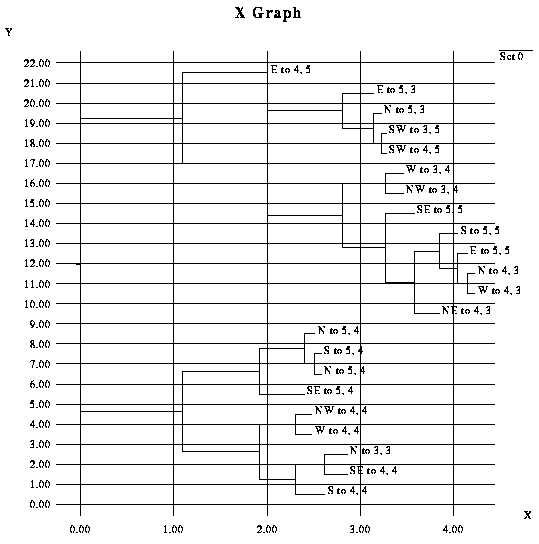Warning: this page is under construction, and may not make much
sense.
The Connectionist Navigational Map (CNM)
The Connectionist Navigational Map (CNM) is an architecture designed
to enable an autonomus robot to learn about the spatial structure of
its environment.
So far, the CNM has only been tested on simple, simulated "grid-worlds":
Stand in the place where you live
Now face North
Think about direction
Wonder why you haven't before
Now stand in the place where you were
Now face West
Think about the place where you live
Wonder why you haven't before
If you are confused check with the sun
Carry a compass to help you along
Your feet are going to be on the ground
Your head is there to move you around
REM, "Stand"
Cluster diagram of the CNM
Here's a cluster analysis of the spatial representations the
Connectionist Navigational Map (CNM) developed on its own. A full
explanation is under construction, but the main point is that the CNM
developed, on its own, similar representations for its different
perspectives on the same locations (as can be seen by the fact that
all the ways of getting to, e.g., the location (4,4) are clustered
together).
This is an example of moving from a perspective-dependent
understanding of a domain to a more objective, more
perspective-independent understanding. I take this type of transition
(and its converse) to be central to cognition.

The output for this diagram was generated using Andy Holland's
implementation of the CNM.
A few references on the CNM are:
- Chrisley, R. "Connectionism, Cognitive Maps, and the Development
of Objectivity," which can be found (in decreasing order of
preference):
- in Artificial Intelligence Review 7 (1993), pp 329-354.
- in Niklasson, L. and Boden, M., eds. (1994) Connectionism in a Broad
Perspective. London: Ellis Horwood.
- as
COGS CSRP No. 259.
- Chrisley, R. (1991) "A Hybrid Architecture for Cognitive Map
Construction & Use," Artificial Intelligence & the Simulation of
Behaviour, Special Issue on Hybrid Models of Cognition, Autumn/Winter,
1991.
- Chrisley, R. (1990) "Cognitive Map Construction and Use: A Parallel
Distributed Processing Approach," in Touretzky, D., Elman, J., Hinton,
G., and Sejnowski, T. (eds.) Connectionist Models: Proceedings of the
1990 Summer School. San Mateo, CA: Morgan Kaufman.
Ron Chrisley

